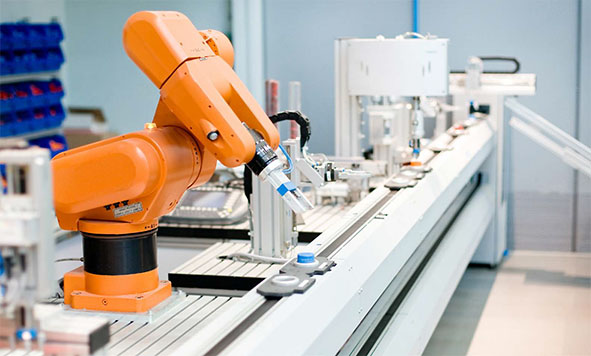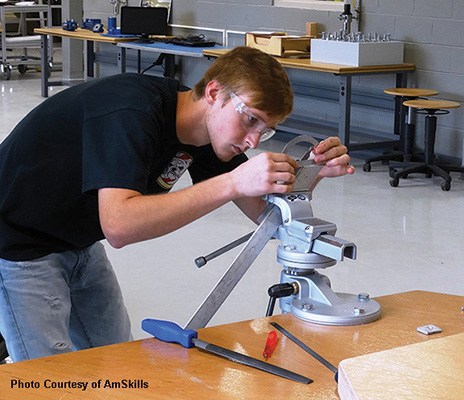
Manufacturers Take Sustainability to New Levels
30 Sep, 2014
By David Hodes
Sustainability has become a standard business practice in manufacturing.
Sustainability, which has been a buzzword in the manufacturing industry for years, has become a necessary fact of good business practice. In fact, sustainability as part of the business-as-usual refrain has jumped into the discussion early in the energy-gobbling manufacturing industry, with manufacturers using sustainability both as a strategic growth proposition and working it as a competitive advantage in their business development in part due to incentives from various state governments.
In recent years, sustainable practices have helped manufacturers come back after the recession with a solid bottom line as a result of the cost savings that new methods of sustainability create.
“There are some companies that have done some really remarkable things,” says Ross Eisenberg, the vice president of energy and resources policy at the National Association of Manufacturers (NAM). “For the end-use product, the consumer product from so many energy-intensive manufacturing operations like aluminum or steel or paper, this is just what they have been doing for a long time with an eye for making their businesses more competitive and actually conserving the resources they use.”
Along the way, using those sustainable manufacturing processes can create positive surprises for both manufacturers and consumers. As an example of the unintended consequences of a sustainable practice, Eisenberg cites Unilever, makers of more than 400 brands of popular foods (Hellmann’s and Lipton) and household products (Dove and Suave).
The company changed to a drip irrigation method for growing tomatoes that was originally implemented just to save water. “And what they discovered after doing that for a while is that they dramatically increased the yield,” Eisenberg says. “They were getting 33 percent more yield just by doing this sustainability water saving business practice.”
Eisenberg says that Unilever also decided to use cage-free eggs to make their mayonnaise. “They are the largest buyers of eggs in the country,” he says. “So buying these cage-free eggs actually forced the buyer industry to do more of that — to make more cage-free eggs available — because there weren’t enough out there to actually meet Unilever’s demand.”
Companies such as Unilever make sustainability a “corporate mantra.” “It comes up in every conversation and drives their decisions. They are committed to it as an absolute cultural thing. – Ross Eisenberg, vice president of energy and resources policy at the National Association of Manufacturers
Companies such as Unilever make sustainability a “corporate mantra,” Eisenberg says. “It comes up in every conversation and drives their decisions. They are committed to it as an absolute cultural thing. And it’s not just about helping the greater good. It’s about making sure that you stay one step ahead of your competitors and be the best in the market.”
To demonstrate the company’s commitment to the environment, Unilever’s CEO, Paul Polman, launched the company’s Sustainable Living Plan in 2010. The plan sets out to decouple the company’s growth from their environmental impact, increasing their positive social impact working with three big goals they hope to achieve by 2020: help more than 1 billion people improve their health and well-being, halve the environmental footprint of their products and source 100 percent of their agricultural raw materials sustainably.
Unilever was ranked first by a wide margin among leaders in sustainability in a recent GlobeScan sustainability survey, far ahead of first runner up Patagonia. The company also created a policy that outlines their goals to work with its paper suppliers to source 75 percent of its paper and board packaging from sustainably managed forests or from recycled material by 2015, rising to 100 percent by 2020.
Technology Drives Sustainability
Another major player in sustainability and manufacturing, specifically “green chemistry,” is New York-based Pfizer Inc., one of the world’s largest pharmaceutical companies, makers of dozens of popular pharmaceuticals and consumer health care products.
Pfizer, as a green chemistry producer, reduced their greenhouse gas (GHG) emissions in their manufacturing process by 20 percent from 2000 to 2007; and then reduced them an additional 25 percent from 2007 to 2012. The company’s next goal is to reduce their GHG emissions by another 20 percent by 2020.
Pfizer incorporates sustainability information in commercial tender requests, and in 2012, implemented 116 energy efficiency projects yielding $3.6 million in annual savings, and reducing greenhouse gas emissions by more than 33,000 tons of CO2.
“Sometimes it takes new materials that might be providing a specific advantage for them and sometimes it is because sustainability is driving that, or sometimes sustainability is a result of that. Sustainability can be an outcome of that new thinking.” – Paul Rumler, Quad Cities Chamber of Commerce
The company participates in the industry-wide Pharmaceutical Supply Chain Initiative, which is a group of major pharmaceutical companies — including Bayer, Bristol-Myers Squibb, Johnson & Johnson, Libby and others — who share a vision of better social, economic and environmental outcomes for all those involved in the pharmaceutical supply chain. This includes improved conditions for workers, economic development and a cleaner environment for local communities.
In China, Pfizer partners with the Institute for Sustainable Communities, an organization committed to advancing sustainability in developing countries through education and training.
Another example of the spread of sustainable manufacturing can be seen with Alcoa, and the company’s entrance into the automotive market a few years ago with their plant in the Quad Cities area, a region that straddles the Iowa and Illinois border, composed of Davenport and Bettendorf in Iowa, and Rock Island and Moline in Illinois.
Sustainability in manufacturing actually follows the legacy of some of the oldest practices in this agricultural-heavy state (Iowa). “And that is because the farmers here are focused on making sure that the land is there for many more years to come,” says Paul Rumler, chief economic development officer and executive vice president of the Quad Cities Chamber of Commerce. “Farmers day in and day out are finding ways to produce more product on the same amount of land,” he says.
Alcoa’s Riverdale plant, makers of aluminum components for the automotive industry, made a $300 million investment in their facility because of sustainability factors that are driving the automotive industry, Rumler says, with a pretreated aluminum process that reduces the overall weight of trucks and cars for better fuel efficiency. “We are starting to see traditional uses redeployed for new product lines, which is going to lead to further efficiencies in the automotive sector,” he says.
Another company in the area, MidAmerican Energy Co., a large utility in the region, is taking advantage of their Iowa location as the “wind tunnel” of the Midwest, providing 40 percent of their energy generating capacity from wind turbines. “With the reemergence of that manufacturing revolution as we call it here in the Quad Cities, we have been talking to manufacturers about what they are doing that is innovative,” Rumler says. “What we have found is that they have ways to continue to innovate within the scope of their business either in their current product line or their next product line, and they have been doing it faster, better, cheaper and more efficiently. Those are all words that we have been hearing. And sometimes it takes new materials that might be providing a specific advantage for them and sometimes it is because sustainability is driving that, or sometimes sustainability is a result of that. Sustainability can be an outcome of that new thinking.”
Rumler thinks technology is really driving sustainability. “As we look at any type of manufacturing, whether it is with a food manufacturer or metals manufacturer, they are using technology in new ways that is leading towards a greater efficiency, focusing people’s time and equipment time, and therefore driving down energy utilization as well,” he says. “So I see that as a trend. And from my point of view it strengthens our position in the global economy, because the U.S. is known as a savvy workforce that is able to deploy these pieces of equipment over the course of different sectors, and that puts us in a strategic competitive position for future growth.”
Eisenberg says from the NAM point of view, sustainability and manufacturing are one in the same, “Because we strive to make the U.S. the best place in the world for manufacturing. And it’s our goal to be the most sustainable place in the world for manufacturers as well. We think we can have both of those things at the same time, and we have committed this organization to work towards those goals.”
Unilever continues its impressive sustainable manufacturing push, recently creating the Sustainable Living Young Entrepreneurs Awards, open to anyone aged 30 or under. The goal of the awards competition is the discovery of scalable and sustainable products, services or applications that reduce environmental impact, improve health and well-being or enhance livelihoods through changes in practices or behaviors.
The award program is run in partnership with the Cambridge Institute for Sustainability Leadership, and offers seven people financial support and individually tailored mentoring.
Last year, more than 500 young entrepreneurs from more than 90 countries entered the competition. Commenting on the awards, Unilever’s Polman said: “I believe that youth hold the key to unlocking solutions to many of the challenges our planet faces. Young people will soon represent 50 percent of the population in developing and emerging countries, but they are 100 percent of the future. So it’s absolutely vital we continue to enroll them in the task of making sustainable living commonplace and invest in their ideas.”
For more details about the organizations featured in this article, visit:
National Association for Manufacturers
Quad Cities Chamber of Commerce
Pre-engineered Solutions Offer Energy Savings
Memphis, Tenn.-based Varco Pruden Buildings, which provides pre-engineered steel building systems, participates in the Cool Roof Rating Council (CRRC) and Leadership in Energy and Environmental Design (LEED). “We are looking at any material for sustainability impact,” says Craig Edwards, director of marketing, Varco Pruden. “Steel is a recyclable material and the life cycle of steel construction is pretty much the best construction method.”
Edwards says the company offers the PrisMAX SL daylight system, which can be installed after the roof has already been erected and put into place. “That allows us to go back in to our builders and add daylighting in an existing building,” he says. “And there is no energy saving like turning the lights off.
“We make sure that the customer is covered for the specific energy codes,” Edwards continues. “But meeting codes is one thing. The biggest owner’s expense, other than employees, is utilities and that is where we help reduce costs with multiple options in wall and roof assemblies.” Learn more about Varco Pruden by visiting www.vp.com.
Illustration by Stuart Miles at Free Digital Photos.net
Related Posts
-

Development in Transition
-

Advanced MFG
-

Advanced Manufacturing Now in Every Industry Sector
-

Manufacturing Combats Workforce Uncertainties
-

Reshoring Essential to Manufacturing’s Renaissance
-

Manufacturing: Growth and Reshoring Shape 2015
-

Cleantech Opportunities on the Rise
-

What does Manufacturing Mean to You? Video
-

Makers Create the Future
-

The Economics of Building Green









